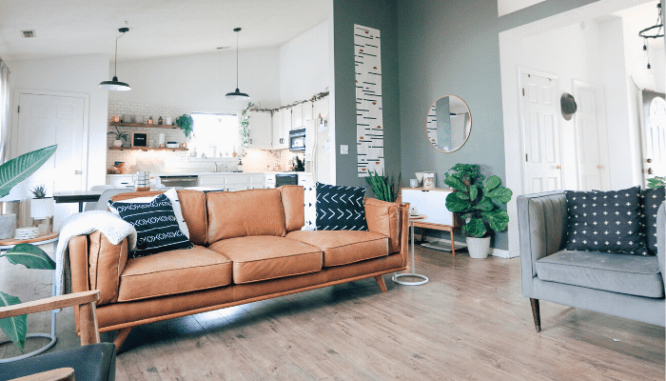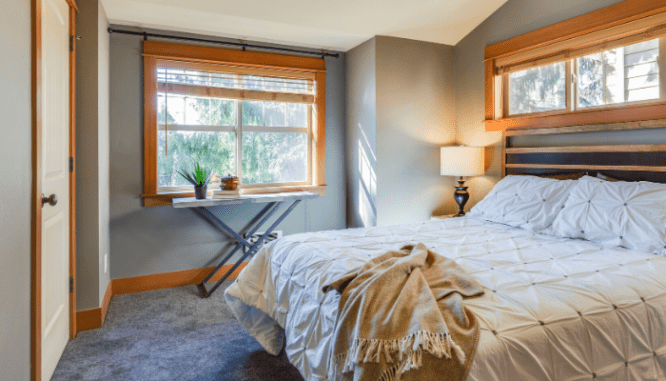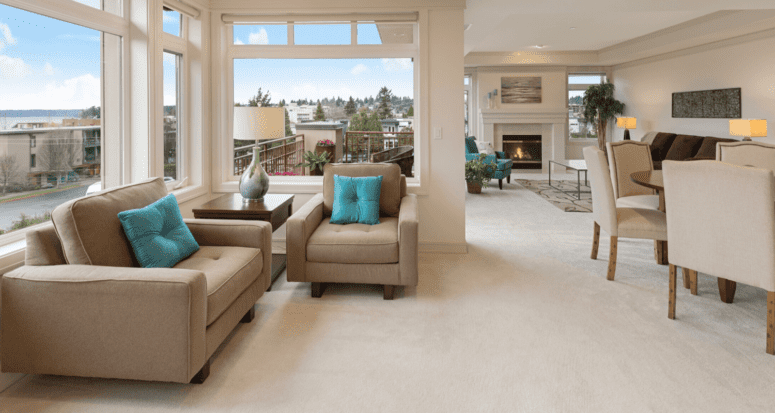All Beige Everything? 8 Home Staging Mistakes to Watch Out For!
- Published on
- 5 min read
-
 Catherine Conelly Contributing AuthorClose
Catherine Conelly Contributing AuthorClose Catherine Conelly Contributing Author
Catherine Conelly Contributing AuthorCatherine has 8 years of experience as a writer and editor. Her work can be seen in PopSugar, Thrillist, Shape, and SheKnows. She holds a Bachelor's Degree in Creative Writing from Arizona State University and currently resides in Arizona.
Julie Chrissis, an award-winning home staging pro in New England, recalls a recent staging project where — wait for it — she used a green couch. Not taupe! Not gray!
Green.
“Five years ago I probably would have been fired,” she jokes. But today, the idea that your whole home has to be neutral is one that many home staging experts are tired of hearing. “It’s important to have character,” she says.
So how do you incorporate color safely when staging your home? At what point does neutral become more harmful than helpful? And what other common mistakes do homeowners make when staging their homes to sell?
While there’s a lot you can do to transform a room, we’re here to help you avoid steering off track!

Mistake #1: You ask “What’s trending?”
Is farmhouse decor still in? What’s the Pantone color of the year again? Good news: It doesn’t matter when you’re staging your home to sell it.
While you want to impress buyers, reading up on the most popular design styles isn’t the way to do it. Don’t risk alienating people because your home is filled with barn doors and the faux shiplap that’s all over Pinterest.
According to Sara Barnes, a coveted home stager on the West Coast whose work has appeared on shows like Desert Flippers and My Lottery Dream Home — staging your home is not the same as interior decorating. Interior decorating is striving for specific styles (think shabby chic, beachy, or industrial), whereas home staging means giving the home just enough personality without pigeonholing it into a specific aesthetic.
Your safest bet is what’s known as transitional style. It’s not too trendy, it’s not too traditional… it’s somewhere in the middle.
“Transitional style gives you that ability to bridge the gap between trendy and traditional,” Chrissis echoes.
According to Barnes, there are a few basics tips to achieving the look:
- Add modern pillows to existing sofas and chairs (like these from West Elm). Mix and match patterns and textures.
- Use rugs in each room to define the space.
- Incorporate abstract art that’s not too personal but adds color and texture to the walls. Here’s an affordable example from Target.
Mistake #2: Neutral overload
True: Making the home feel light, airy, and somewhat neutral is crucial. But it’s also possible to go so far in the direction of bland, boring, and sterile that your home lacks personality and life. Contrary to popular belief, you don’t have to be afraid of color!
If you have a bigger living area with a lot of natural light and high ceilings, you have some creative breathing room to add a focal wall. Barnes recalls a dark navy wall she recently painted for a client. “It turned out stunning,” she says.
But she doesn’t recommend it for small rooms with low ceilings or bungalow-style homes. That’s when it becomes a risky trick, and it can make the room feel small, dark, and closed-in. A general rule of thumb is to leave the furniture neutral and bring in color with the rugs, pillows, and throw blankets (and, yes, maybe an accent wall).

Mistake #3: Years-old paint
In HomeLight’s Top Agent Insights Survey, 100% of agents surveyed said they always recommend a fresh coat of paint when getting the house ready to sell.
If your walls are already neutral, there’s one great reason to paint anyway: It makes potential buyers feel like the home is brand new.
“It’s going to create that look and smell of a new home that is going to feel fresh to buyers,” says Barnes.
Another hint? Look up. Your ceiling may also benefit from a fresh coat of white.
Here are a few wall-color recommendations:
You can find more home staging interior paint ideas from HomeLight’s guide to neutral (but never boring) colors!
Mistake #4: Rooms that feel like dungeons
Shades open, lamps on, rooms lit — there’s power in showing your house with lots of light. “Getting the lighting right is a big deal,” says Brooks Bailey, a top listing agent in Redlands, California. Here’s how to do it:
1. Take down heavy or dark-colored window treatments.
Bulky fabrics, draped tassels, and anything that blocks light needs to go. But you also don’t want the window to look bare. Stick to light and translucent curtains that accent your window but don’t block light.
2. Count the number of lights in each room.
Add a light source in any space where you have fewer than four lights. This can include lamps, the number of recessed lights, and sconces.
3. Use cool LED lights, not warm ones.
Michelle Minch, an award-winning home stager, swears by soft or warm LED white bulbs with about 3,000 Kelvins and no less than 800 lumens. And most importantly, make sure all bulbs in your home are the same so rooms look cohesive.

Mistake #5: Poor furniture placement
We tend to put couches and chairs up against walls, but look at any room you admire on Pinterest. Notice how the furniture sits a few feet from the walls to give way to big windows and natural light, and to create walkways.
Chrissis cautions that you should always be thinking about how the room will photograph and show at an open house.
While you may not want furniture hiding in corners, you also don’t want large pieces of furniture becoming a barrier.
“Now you have a traffic flow problem at an open house,” she says. “People say, well, ‘I can’t entertain here. If this is a log jam, what am I going to do at Thanksgiving?’”
Here are a few steps to playing with furniture arrangement:
- Start with a rug in the center of your room to define the space. Experiment with furniture arrangements around that to create conversation areas.
- Consider where your agent will stand to shoot your listing photos. Make sure the furniture won’t hog the photo at those angles.
- Consider how people will move through the space during a showing or open house. Remove chairs or other large pieces that disrupt the flow.
Mistake #6: Your big comfy couch
Even if you love your couch and it jives with the transitional style you’re going for, if it’s too large, it will make your room look smaller. (Keep in mind, this works the other way, too.)
“Oddly enough, a bigger room will appear smaller without furniture,” says Barnes.
So if your home is vacant, hire someone to stage those important rooms. According to HomeLight’s Top Agent Insights report, nearly 90% of agents said the living room takes precedence when they stage a home. Vying for second and third, roughly 65% of agents were most likely to stage the kitchen, while 60% put their stock in the bedrooms.
According to HomeAdvisor, the national average cost to stage your home is about $1,000 — an investment, sure, but staging costs are also tax deductible (in a sense).
You can’t write them off the way you would your mortgage interest. However, staging costs can be subtracted from the sale price, similar to the commission you pay to your agent — which affects the final dollar amount of capital gains you’re taxed on (read a whole blog post about it here). Plus, Bailey mentioned it’s not uncommon for buyers to ask to buy the furniture along with the house.
Pay to have it done right, and you may get more than you bargained for.

Mistake #7: Neglecting the outdoors
Imagine if you were to get all dressed up for a fancy gala only to leave your hair disheveled. People may see the fancy dress as a cover for bad hygiene. The same thing goes with a neglected yard.
It ruins the peace of mind that you’ve taken care of your home, no matter how nice all the finishing touches look inside.
When your yard is clean-cut, it shows that you’re taking care of your house. “Buyers think, ‘OK, they’re on top of stuff out here,’” says Bailey. Here are a few ways to stage outdoor areas, aside from basic lawn maintenance and pulling weeds.
- Set up a bistro table and chairs with a cute centerpiece — like these ideas from Better Homes & Gardens.
- Use string lights to define cozy sitting areas.
- Top potted plants with cedar bark to make them more aesthetically appealing.
Mistake #8: You staged — but didn’t clean up
“People forget about the value of the smell of a clean home,” says Barnes.
No one is going to care about a well-designed room… if it has gross carpet and dusty shelves.
So clean like you were hired to do it. Use HomeLight’s deep cleaning checklist to make sure you don’t miss a spot in the kitchen, baths, and bedrooms. Make sure your windows are sparkling and clear so they can let in lots of light. Deep clean those carpets and get out your hardwood floor polisher.
Sweep and organize the garage, and remove any oil stains from the floors. And be sure to focus your cleaning efforts on the entryway (no fingerprints on the doorknob, remove cobwebs from any light fixtures) so that visitors have a great first impression.
Just remember: your house has been good to you, so do it justice before you move on to make memories in a new space. You’ve been on the other end of this equation, clicking through listing photos and passing judgment on which properties are worth seeing in person. Make sure your home makes the cut for potential buyers going through the process of elimination. Avoiding these traps is a good place to start.
Header Image Source: (Francesca Tosolini / Unsplash)
